|
|
|||
THIS WEEK at HILTON POND
22-31 October 2006
Installment #334---Visitor #
(Back to Preceding Week; on to Next Week)
|
WHEN IT'S DREARY AND COLD |
|
A WEEK OF RUFOUS HUMMINGBIRDS:
PERDITA, et al. Nearly all Ruby-throated Hummingbirds disappear by mid-October from the north central Piedmont Region of South Carolina, eventually ending up in Mexico or Central America for a slightly more leisurely "winter vacation." Our latest ever ruby-throat was on 18 October 1986, but a more typical late date would be around the 7th of the month; this year our last sighting was on the 4th. For a few folks there's scarcely a lull between the departure of ruby-throats and the arrival of more exotic winter hummingbird species--as is the case for "Lucky" Lenore Berry of Rock Hill SC. In 2006, as during the preceding three Octobers, Lenore had scarcely seen her last ruby-throat before being greeted by a hummer that looked both different and familiar--a female Rufous Hummingbird far from her expected winter home in Central Mexico and so well-known to Lenore she has her own name: "Perdita, the Wanderer." Going to see Perdita for the fourth year in a row would have made for a pretty good week, but she's just one of three Rufous Hummingbirds we were privileged to capture recently during our own wanderings away from Hilton Pond.
All text & photos © Hilton Pond Center Perdita (2006 photo above) is indeed an old friend of Lenore Berry's, at least since late fall 2003 when the hummingbird first showed up at a feeder still filled with sugar water. After spotting this unexpected bird, Lenore became aware of our interest in winter hummingbirds, sent us an e-mail, and invited us to visit her home to view her unusual guest. Visit we did on 5 December 2003, and because we had our portable hummingbird trap we were able to capture, identify, band, and release unharmed what was at that time a "hatch-year" female Rufous Hummingbird born sometime that summer. The Berry family dubbed her "Perdita."
Perdita continued to visit two feeders at the Berry residence all winter--she was a good addition for that year's York/Rock Hill Christmas Bird Count--and departed early in spring 2004. We can only presume she headed for the species' breeding grounds in southern Alaska, western Canada, or the Pacific Northwestern U.S. That autumn we got another e-mail from Lenore saying she had a winter hummer; our subsequent trap deployment allowed us to recapture what turned out to be the now-familiar #14855, AKA Perdita. Beacuse huge numbers of hatch-year hummingbirds--perhaps 70-80%--fail to survive their first winter, in November 2004 we were pleased once more to see Lenore's wandering hummingbird, by now designated "second-year."
As usual, Perdita spent the winter at the Berry house, departed in spring 2005, and showed up in October that year for her annual recapture and photo shoot. By now Lenore was understandably attached to her third-year hummingbird friend. We're certain she thought often about Perdita after the bird bid adieu to Rock Hill in spring 2006, and we can only imagine the growing anticipation Lenore felt this fall as her ruby-throats disappeared and the feeder was temporarily unoccupied. Amazingly, that anticipation didn't last long, with Perdita showing up like clockwork on or about 19 October.
We usually wait for colder weather to try catching winter hummingbirds--the presence of still-blooming plants and autumn insects might distract a hummer from entering a trap baited with sugar water--but we felt confident we could capture Perdita early in the season. (Plus, we were hungry for some of that delicious homemade nut bread Lenore always has for us when we visit.) Thus, before dawn on the morning of 24 October we arrived hungry at the Berry house, set our trap, and waited for Perdita. Shortly after first light we saw a blur of wings and could tell a hummingbird was trying to get at the feeder within the trap. Sometimes these winter birds take numerous visits to figure out how to enter, but Perdita only took two or three; by 7:30 a.m. we had her in hand to verify that familiar band inscription of #14855. After taking the requisite photos (above) and measurements (below), we handed Perdita to Lenore for release, and her hummer was free to grace the Berry property for yet another winter season.
At four years of age, Perdita is not the oldest known Rufous Hummingbird--the Bird Banding Laboratory has records for one that was at least 8 years 11 months--but she very well could be the matriarch for her species in South Carolina.
This bird already had molted in some of the rusty back feathers (above) that eventually would cover nearly its whole body, so we knew it to be a young male that couldn't be more than about six months old. As an added hint, the bird's gorget (see photos above right and just below) had an asymmetrical pattern; i.e., all the metallic feathers were clumped at bottom center of the throat and on the left side. Such a pattern would not have occurred on a female, which would be likely to have a more or less uniform scattering of iridescent gorget feathers like Perdita (see photo at top of page).
Ventral (above) and lateral views (below) of the Stordock's bird reveal extensive rusty coloring on its flanks. This is typical of a Rufous Hummingbird, although in some females and young males it is not as pronounced. Lightly colored flanks also occur in many female and young male Ruby-throated Hummingbirds, but such coloration is more buffy and far less intense than in the Rufous.
In our experience, vagrant male Rufous Hummingbirds of any age are far less common than females in the Carolinas. Assuming their bird stays the winter, Diane and Steve Stordock will get the rare treat of watching the mainly green young male molt into the brilliant rusty plumage of an adult male, complete with a full orange-red gorget.
After completing all our work, we placed the bill of the Stordock's bird into a port on their hummingbird feeder and watched as the bird took a few quick hits of sugar water. After that both Steve and Diane (above) had rare opportunities to examine the bird up close before it eventually flew to roost in a pine tree behind their residence. Thanks to the Stordocks for allowing us to visit. Vital Statistics for As part of our education outreach via Hilton Pond Center and Operation RubyThroat: The Hummingbird Project, we maintain a Yahoo! group called Hummingbird Hobnob. Through "Hobnob" we often get reports of winter vagrant hummingbirds. Those that are reasonably close we investigate as soon as possible; more distant birds we refer to the network of hummingbird banders spread around the country. When Jean Thorne of Connelly Springs NC posted to "Hobnob" a note she was hosting a hummer, we suggested she try to get a photo. The telephoto shot she took (above right) indicated her guest was probably a female Rufous Hummingbird, so Jean and husband Michael asked us to come band it and confirm the ID early on the morning of 27 October.
We arrived before sunrise at the Thorne residence--just south of South Mountains State Park and only about four straight-line miles from the spot where we banded (and later recaptured) a Rufous Hummingbird at Casar NC back in 2001. The Thornes live in a relatively isolated mountain community and wondered--as we did--how a solitary wandering Rufous could even find the feeder hanging from their back deck in the middle of the woods.
Under a still-dark overcast sky, we moved the Thorne's feeder into our portable trap, re-hung the device, and sat down to wait. The bird arrived shortly thereafter at about 7:30 a.m., took a look at the trap, and wasted little time in entering. In turn, we pushed the lever that sends an electronic signal to close the trap and the hummer was secured.
The Thorne bird was much paler than the young male we had caught the day before at the Stordock residence, but that doesn't always mean the bird's a female. Unless it's an adult male, the best clues to a hummingbird's sex are the general pattern of the metallic gorget feathers AND the cumulative measurements. As in ruby-throats, male Rufous Hummingbirds are smaller than females, and Jean Thorne's bird was relatively large. Its size also meant it couldn't be the smaller Allen's. This early in the season it's usually easy to determine a vagrant hummingbird's age--or at least whether it's a first-year bird. When young hummingbirds hatch, their bills are quite short but grow rapidly as they mature in the nest. At fledging the bill is essentially full-grown and marked throughout its length by tiny corrugations, or etchings. These either wear off or fill in beginning at the tip, so a bird with complete corrugations (100%) is young and one with none or only a few etchings at the bill's base is "old." Jean's bird had 70% corrugations, a sure sign it was still in its first year.
Young birds are also characterized by plumage (as above) that looks rough, has brownish edges, and/or is not as intensely colored as that of an adult. All this was true of the bird at Connelley Springs, so feather condition confirmed it was a hatch-year bird.
In female Rufous Hummingbirds, the tail also may help as an indicator of age. In many younger birds, all the rectrices have more rounded tips (as above), while in most older females the inner two tail feathers on either side are more or less nippled at the tip. (See tail photo in the Pedita account above for an example of slight nippling.) This is a very subtle characteristic, however, and should be used in conjunction with bill corrugation and plumage condition. Vital Statistics for
Thanks to Jean and Michael Thorne (above) for allowing us to band their Rufous Hummingbird and especially to Jean for a set of photos we'll be using on the Operation RubyThroat Web site. All in all, the last week in October turned out to be pretty productive with regard to winter vagrant hummers. We banded two hatch-year Rufous Hummingbirds--both of which were still coming to their respective feeders through 31 October--and got good examples of the differences between young males and females of the species. We also made four new human friends and got to share with the Stordocks and Thornes the process by which hummingbirds are captured and banded. It was, of course, good to see Lenore Berry again and to partake of her tasty toasted nut bread, but what was really special was once again getting a close look at four-year-old Perdita. We can't predict the longevity of those two young birds we just banded, but it looks like ol' Perdita is a true survivor. We can't wait until next October to see if this western wanderer shows up again in 2007 at the Berry residence in Rock Hill SC--not too far down the road from Hilton Pond Center.
All text & photos © Hilton Pond Center NOTE: For a complete list of vagrant hummingbirds we've banded in the Carolinas--as well as additional discussion about what might be causing increased reports of these visitors, please see Vagrant & Winter Hummingbird Banding. The Web page also contains info about how to care for winter hummers if you get one; if you do, please let us know by sending an e-mail to RESEARCH.
Comments or questions about this week's installment?
Thanks to the following fine folks for recent gifts in support of Hilton Pond Center for Piedmont Natural History and/or Operation RubyThroat: The Hummingbird Project. Your contributions allow us to continue writing, photographing, and sharing "This Week at Hilton Pond." (See Support if you'd like to make a gift of your own.)
"This Week at Hilton Pond" is written & photographed You may wish to consult our Index of all nature topics covered since February 2000. You can also use our on-line Hilton Pond Search Engine at the bottom of this page. For a free, non-fattening, on-line subscription to |

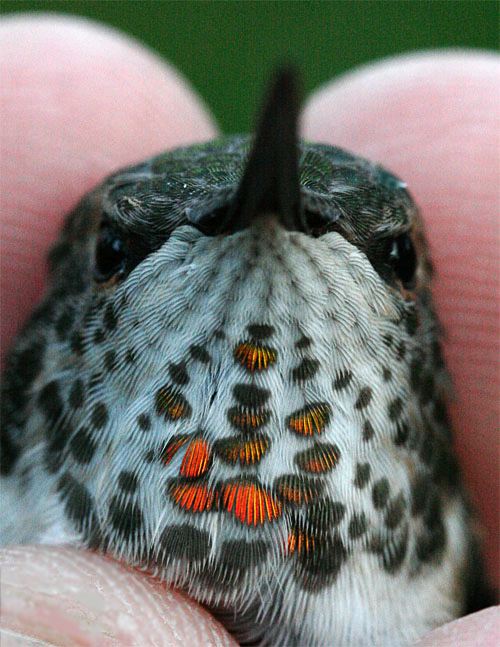
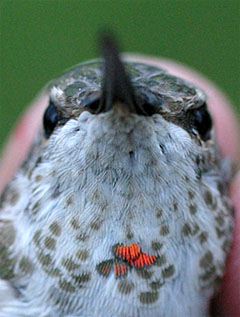 .
.  .
. 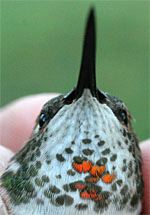 "Perdita" (Rufous Hummingbird #Y14855) in (left to right) Dec 2003 (hatch year), Nov 2004 (second year) & Dec 2005 (third year). Compare with top photo from Oct 2006 (fourth year).
"Perdita" (Rufous Hummingbird #Y14855) in (left to right) Dec 2003 (hatch year), Nov 2004 (second year) & Dec 2005 (third year). Compare with top photo from Oct 2006 (fourth year).
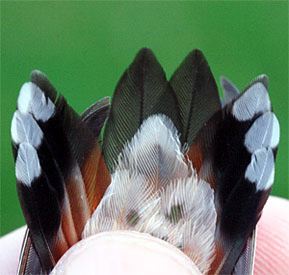 . .
. . 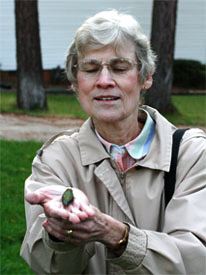
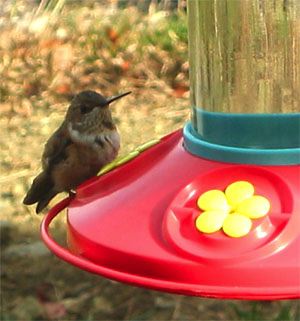 Two days after recapturing four-year-old Perdita, we encountered another Rufous Hummingbird--this one at the other end of the age spectrum. We had gotten an e-mail and digital photos taken through window glass (left) from Diane Stordock in Newport SC, a once-quiet little hamlet halfway between Rock Hill and Hilton Pond Center in York. Diane's note said she had first seen an unusual hummingbird at her feeder on about 17 Oct and invited us to visit for the capture and banding process. We guessed the Stordock bird was a young male Rufous, so on 26 October we took the short drive to Newport, set our trap in the pre-dawn darkness, and went indoors to wait beneath a wall hanging of Coach Vince Lombardi--chatting all the while with Diane and husband Steve, an inveterate Green Bay Packers fan.
Two days after recapturing four-year-old Perdita, we encountered another Rufous Hummingbird--this one at the other end of the age spectrum. We had gotten an e-mail and digital photos taken through window glass (left) from Diane Stordock in Newport SC, a once-quiet little hamlet halfway between Rock Hill and Hilton Pond Center in York. Diane's note said she had first seen an unusual hummingbird at her feeder on about 17 Oct and invited us to visit for the capture and banding process. We guessed the Stordock bird was a young male Rufous, so on 26 October we took the short drive to Newport, set our trap in the pre-dawn darkness, and went indoors to wait beneath a wall hanging of Coach Vince Lombardi--chatting all the while with Diane and husband Steve, an inveterate Green Bay Packers fan.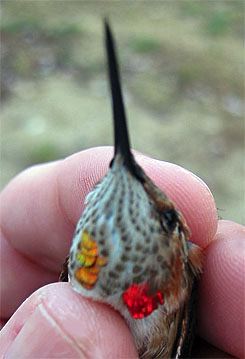 It wasn't long until the Stordock's vagrant hummingbird showed up in search of breakfast; after a few exploratory trips it entered the trap and was captured at about 7:30 a.m. As we prepared to extricate the bird, it was quite apparent we had caught a Selasphorus hummer; the tell-tale rusty bases of the tail feathers were obvious even through the trap, meaning the bird was either a Rufous (S. rufus) or an Allen's (S. sasin). Odds are always on the former--there's never been an Allen's reported for South Carolina--but to be sure we removed the bird from the trap and took measurements that confirmed it was the somewhat larger Rufous. (Among other things, the tail feathers of Allen's Hummingbirds are much narrower than those of the Rufous; in fact, the outermost, shortest rectrices in Allen's are only about half the width of similar Rufous feathers.)
It wasn't long until the Stordock's vagrant hummingbird showed up in search of breakfast; after a few exploratory trips it entered the trap and was captured at about 7:30 a.m. As we prepared to extricate the bird, it was quite apparent we had caught a Selasphorus hummer; the tell-tale rusty bases of the tail feathers were obvious even through the trap, meaning the bird was either a Rufous (S. rufus) or an Allen's (S. sasin). Odds are always on the former--there's never been an Allen's reported for South Carolina--but to be sure we removed the bird from the trap and took measurements that confirmed it was the somewhat larger Rufous. (Among other things, the tail feathers of Allen's Hummingbirds are much narrower than those of the Rufous; in fact, the outermost, shortest rectrices in Allen's are only about half the width of similar Rufous feathers.)


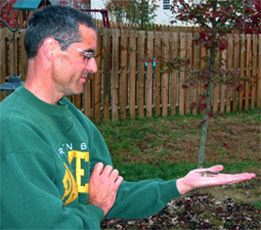 . .
. . 
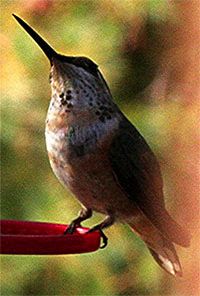 With more than 830 members, it's the largest hummingbird group on the Web, and the membership actively engages in sharing all sorts of information about hummers; there's even a series of on-line albums with photos of hummingbirds and plants that attract them.
With more than 830 members, it's the largest hummingbird group on the Web, and the membership actively engages in sharing all sorts of information about hummers; there's even a series of on-line albums with photos of hummingbirds and plants that attract them.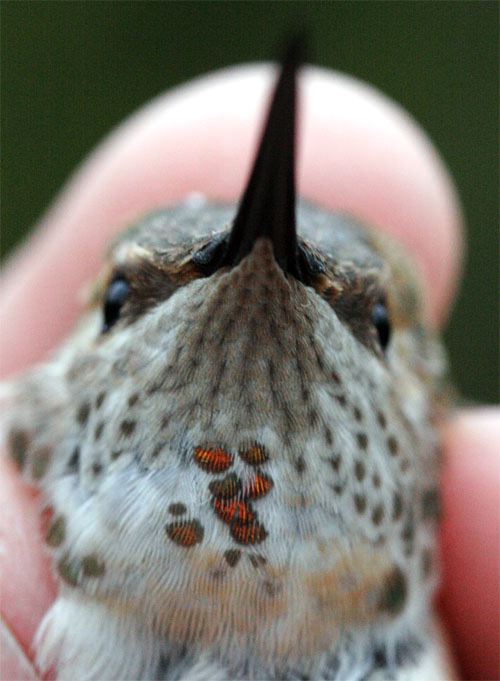

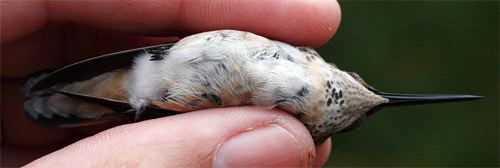

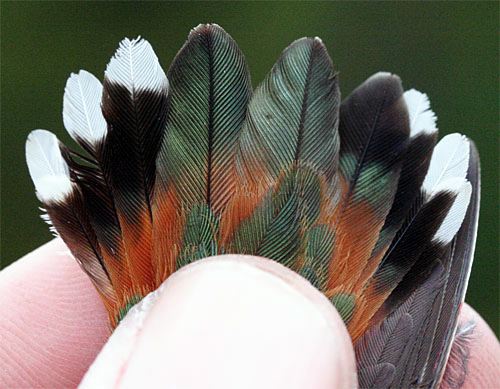
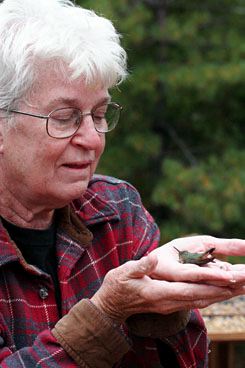 . .
. . 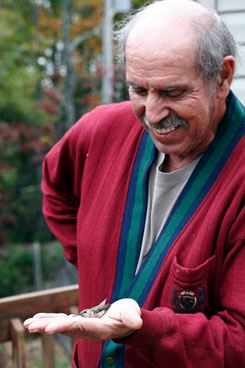


 Please report your
Please report your Oct 15 to Mar 15
Oct 15 to Mar 15
